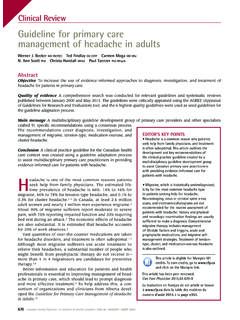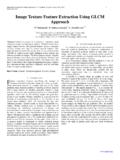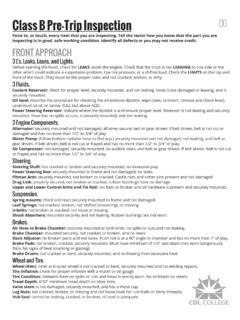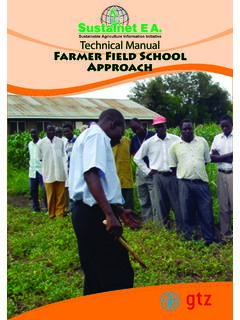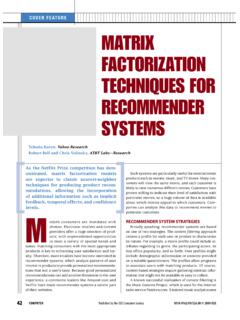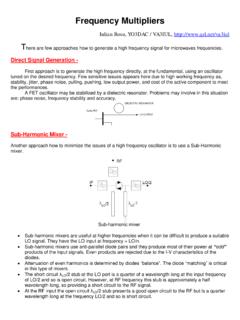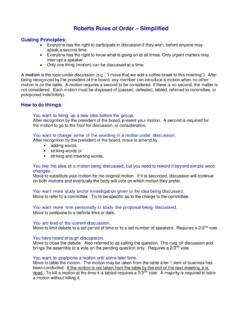Transcription of Simplified guideline for prescribing medical cannabinoids ...
1 Vol 64: FEBRUARY | F VRIER 2018 | Canadian Family Physician | Le M decin de famille canadien 111 CLINICAL PRACTICE GUIDELINESA bstractObjective To develop a clinical practice guideline for a Simplified approach to medical cannabinoid use in primary care; the focus was on primary care application, with a strong emphasis on best available evidence and a promotion of shared, informed decision making. Methods The Evidence Review Group performed a detailed systematic review of 4 clinical areas with the best evidence around cannabinoids : pain, nausea and vomiting, spasticity, and adverse events. Nine health professionals (2 generalist family physicians, 2 pain management focused family physicians, 1 inner-city family physician, 1 neurologist, 1 oncologist, 1 nurse practitioner, and 1 pharmacist) and a patient representative comprised the prescribing guideline Committee (PGC), along with 2 nonvoting members (pharmacist project managers).
2 Member selection was based on profession, practice setting, location, and lack of financial conflicts of interest. The guideline process was iterative through content distribution, evidence review, and telephone and online meetings. The PGC directed the Evidence Review Group to address and provide evidence for additional questions as needed. The key recommendations were derived through consensus of the PGC. The guideline was drafted, refined, and distributed to a group of clinicians and patients for feedback, then refined again and finalized by the Recommendations include limiting medical cannabinoid use in general, but also outline potential restricted use in a small subset of medical conditions for which there is some evidence (neuropathic pain, palliative and end-of-life pain, chemotherapy-induced nausea and vomiting, and spasticity due to multiple sclerosis or spinal cord injury).
3 Other important considerations regarding prescribing are reviewed in detail, and content is offered to support shared, informed decision making. Conclusion This Simplified medical cannabinoid prescribing guideline provides practical recommendations for the use of medical cannabinoids in primary care. All recommendations are intended to assist with, not dictate, decision making in conjunction with s key points This Simplified prescribing guideline was developed with a primary care focus. guideline contributors were selected based on profession, practice setting, and location to represent a variety of key stakeholders (particularly primary care) from across the country, as well as on the absence of financial conflicts of interest.
4 Although cannabinoids have been promoted for an array of medical conditions, the evidence base is challenged by bias and a lack of high-level research. Two large evidence synopses suggested that only 3 conditions have an adequate volume of evidence to inform prescribing recommendations: chronic pain, nausea and vomiting, and spasticity. The guideline suggests that clinicians could consider medical cannabinoids for refractory neuropathic pain and refractory pain in palliative care, chemotherapy-induced nausea and vomiting, and spasticity in multiple sclerosis and spinal cord injury after reasonable trials of standard therapies have failed. If considering medical cannabinoids and criteria are met, the guideline recommends nabilone or nabiximols be tried first.
5 Harms are generally more common than benefits are, and it is important to discuss the benefits and risks of medical cannabinoids with patients for whom they are being guideline for prescribing medical cannabinoids in primary care G. Michael Allan MD CCFP Jamil Ramji Danielle Perry Joey Ton PharmD Nathan P. Beahm PharmD Nicole Crisp RN MN NP-Adult Beverly Dockrill RN Ruth E. Dubin MD PhD FCFP DCAPM Ted Findlay DO CCFP FCFP Jessica Kirkwood MD CCFP Michael Fleming MD CCFP FCFP Ken Makus MD FRCPC Xiaofu Zhu MD FRCPC Christina Korownyk MD CCFP Michael R. Kolber MD CCFP MSc James McCormack PharmD Sharon Nickel Guillermina No l MDes PhD Adrienne J.
6 Lindblad ACPR PharmD112 Canadian Family Physician | Le M decin de famille canadien Vol 64: FEBRUARY | F VRIER 2018 CLINICAL PRACTICE GUIDELINESBox 1. Recommendations summaryGeneral recommendation We recommend against use of medical cannabinoids for most medical conditions owing to lack of evidence of benefit and known harms (strong recommendation) -Potential exceptions are reviewed below: some types of pain, CINV, and spasticity due to MS or SCIM anagement of pain Acute pain: We strongly recommend against use of medical cannabinoids for acute pain management owing to evidence of no benefit and known harms (strong recommendation) Headache: We recommend against use of medical cannabinoids for headache owing to lack of evidence and known harms (strong recommendation) Rheumatologic pain.
7 We recommend against use of medical cannabinoids for pain associated with rheumatologic conditions (including osteoarthritis and back pain) owing to lack of evidence and known harms (strong recommendation) Neuropathic pain: We recommend against medical cannabinoids as first- or second-line therapy in neuropathic pain owing to limited benefits and high risk of harms (strong recommendation) -Clinicians could consider medical cannabinoids for refractory neuropathic pain, with the following considerations (weak recommendation): a discussion has taken place with patients regarding the benefits and risks of medical cannabinoids for pain patients have had a reasonable therapeutic trial* of 3 prescribed analgesics and have persistent problematic pain despite optimized analgesic therapy medical cannabinoids are adjuncts to other prescribed analgesics Palliative (end-of-life) cancer pain.
8 We recommend against use of medical cannabinoids as first- or second-line therapy for palliative cancer pain owing to limited benefits and high risk of harms (strong recommendation) -Clinicians could consider medical cannabinoids for refractory pain in palliative cancer patients, with the following considerations (weak recommendation): a discussion has taken place with patients regarding the risks and benefits of medical cannabinoids for pain patients have had a reasonable therapeutic trial* of 2 prescribed analgesics and have persistent problematic pain despite optimized analgesic therapy medical cannabinoids are adjuncts to other prescribed analgesics Types of medical cannabinoids for pain: -If considering medical cannabinoids , we recommend a pharmaceutically developed product (nabilone or nabiximols) as the initial agent (strong recommendation) Nabilone is off-label for pain and has limited evidence of benefit.
9 However, it is less expensive than nabiximols and dosing is more consistent than for smoked cannabis Nabiximols is expensive and, in some provinces, only available through specialist prescribing or special authorization. However, nabiximols has better evidence than nabilone does -If considering medical cannabinoids , we recommend against medical marijuana (particularly smoked) as the initial product (strong recommendation) Evidence for smoked cannabis has a very high risk of bias, and long-term consequences are unknown Products available can have far higher concentrations of THC and CBD than those researched Management of nausea and vomiting General.
10 We recommend against use of medical cannabinoids for general nausea and vomiting owing to the lack of evidence and known harms (strong recommendation) -We strongly recommend against medical cannabinoids for nausea and vomiting in pregnancy or hyperemesis gravidarum owing to the lack of evidence, known harms, and unknown harms (strong recommendation) CINV: We recommend against use of medical cannabinoids as first- or second-line therapy for CINV owing to limited comparisons with first-line agents and known harms (strong recommendation) -Clinicians could consider medical cannabinoids for treatment of refractory CINV, with the following considerations (weak recommendation): a discussion has taken place with patients regarding the risks and benefits of medical cannabinoids for CINV patients have had a reasonable therapeutic trial of standard therapies and have persistent CINV medical cannabinoids are adjuncts to other prescribed therapies Types of medical cannabinoids for CINV.

